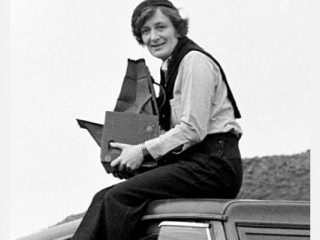
Dorothea Lange biography
Date of birth : 1895-05-26
Date of death : 1965-10-11
Birthplace : Hoboken, New Jersey, U.S.
Nationality : American
Category : Famous Figures
Last modified : 2011-02-23
Credited as : Photographer, Three Mormon Towns, Death of a Valley
Dorothea Lange was one of the best of the American photographers who used their art to document, and ultimately to alleviate, the human suffering caused by the Great Depression of the 1930s. As she viewed it, photography was not an end in itself, but a means of exploring the world so as to improve it.
Born of second generation German immigrants on May 26, 1895, in Hoboken, New Jersey, Dorothea Lange was named Dorothea Margaretta Nutzhorn at birth. She dropped her middle name and assumed her mother's maiden name after her father abandoned the family, one of two traumatic incidents in her early life. The other was her contraction of polio at age seven which left her lame throughout her life.
She attended public schools in New York City and from 1914 through 1917 was enrolled in the New York Training School for Teachers. At about this time she decided to become a professional photographer.
Lange worked in the photography studios of Arnold Gen the and Charles H. Davis and attended Clarence H. White's photography class at Columbia University before moving to San Francisco, where she established a portrait studio in 1919. In 1920 she married Maynard Dixon, a painter. They were divorced in 1935.
Her successful portrait business came to an end during the Depression, as she turned her attention to people caught in the trap of desperate poverty by a combination of a collapsed economy, natural disasters, and technological obsolescence. One of her best known pictures, the first to become widely recognized, was "White Angel Breadline" (1932), made outside her studio in San Francisco. A crowd of recently unemployed men are shown waiting for a handout; the centerpiece is a single figure of an elderly man hunched over a railing, holding a cup between his hands. The picture became one of the earliest of the decade to illustrate the plight of American lives disrupted by economic hardship.
Some of her work was exhibited at the Oakland studio of photographer Willard Van Dyke, who also wrote about her pictures in Camera Craft. At about the same time she began an association with Paul S. Taylor, a University of California sociologist and economist who began to use her work to accompany his studies of populations displaced by hard times. They were married in 1935, shortly after her divorce from Dixon, and collaborated on An American Exodus: A Record of Human Erosion (1939).
As a result of the growing recognition of the quality of her work in 1935, Lange was invited by Roy Stryker to join the photography unit of the federally sponsored Resettlement Administration (soon to be named FSA, the well-known Farm Security Administration), under Stryker's direction. The small group of photographers, which included such notables as Arthur Rothstein, Carl Mydans, Walker Evans, and Ben Shahn, remained in existence until 1942, when it was transferred to the Office of War Information. Some of Dorothea Lange's finest work, including the famous "Migrant Mother" (1936), was produced for FSA.
During World War II she was hired by the War Relocation Authority to document the internment of Japanese-Americans for the duration of the war. The work done in the camps was not seen publicly until years later in the exhibition and book by Maisie and Richard Conrat, Executive Order 9066 (1972). Lange also worked in the Office of War Information, her photographs appearing uncredited in Victory magazine.
In 1945 she photographed the United Nations Conference in San Francisco for the State Department; did assignments for LIFE magazine, including "Three Mormon Towns" (1954) and "The Irish Country People" (1955); and recorded "Death of a Valley" (1960) for Aperture. Her career was crowned at the end of her life with a retrospective exhibition for the Museum of Modern Art, which was shown in 1966, after her death from cancer in 1965.
Dorothea Lange was comfortable with everyone that she encountered, but particularly with the down-and-outers, the silent and invisible population suffering from circumstances beyond their understanding or control. Such people trusted her, and she viewed and exhibited them with compassion and respect. Her ease with subjects, dedication to the improvement of their lot, and mastery of her chosen form of communication help place her work among the most enduring of its kind.
The most extensive and authoritative study of Lange's life and work is Milton Melter's engrossing Dorothea Lange: A Photographer's Life (1978). Dorothea Lange also appears in Notable American Women (1980). The Museum of Modern Art publication that accompanied the exhibition of her work at the end of her life provides a cross-section of her production, which is explicated with an introduction by George P. Elliot. For a good example of her activities during the 1930s, see An American Exodus (1939), which she co-authored with Paul S. Taylor.
















